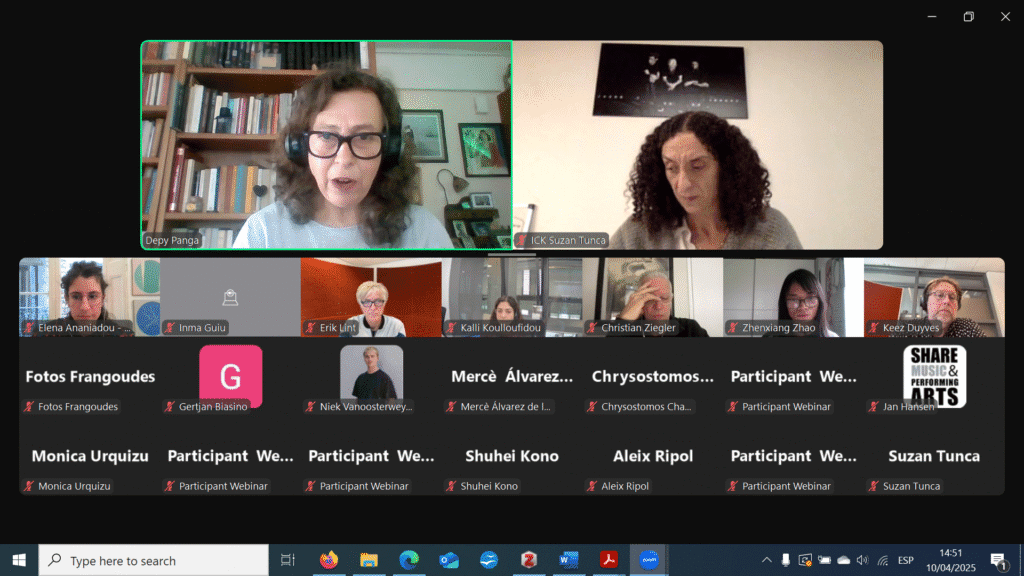April 10, 2025
The second PREMIERE project webinar, held on April 10, 2025, explored how performers, teachers, and directors can utilize XR spaces for virtual meetings and creative collaboration. Unlike the previous session, this webinar focused more on participant engagement and featured presentations from Susan Tunca of ICK Dans Amsterdam and Depy Panga of Argo Theatre.
Virtual co-creation in performance spaces
The webinar centered on one of PREMIERE’s key research areas: performing with XR technologies. In this session, the presenters shared their experiences with a specific use case – actor-dancer virtual co-creation performance – developed in collaboration with CYENS from Cyprus.
Susan Tunca, Head of ICK Academy, demonstrated how ICK Amsterdam has been exploring the concept of remote rehearsal and knowledge transmission in VR spaces. She presented footage from March 2023 showing an early experiment where she conducted a dance class from Amsterdam with a dancer located in Cyprus through a virtual environment.
“The aim is how dancers who are not in the same space can have the experience that they are together in real time, which would be the departure point to be able to share dance knowledge or to rehearse,” Tunca explained.
The experiment revealed both challenges and possibilities. While the avatar representations were still rudimentary at that stage of development, requiring simultaneous Zoom connections for clearer communication, they highlighted the potential for remote collaborative dance instruction.
The intuitive body and technology
Tunca framed ICK’s approach through what they call “the intuitive body” concept. Quoting ICK’s artistic director, she emphasized: “Besides its physiological and biological function, I consider the body as pure technology. The way it interconnects, receives and transmits information—that’s where I see technology.”
This perspective guided their engagement with the project, positioning the body as the departure point rather than allowing technology to overshadow physical presence. “Our aim is not that everything goes to the tech and you lose the body, but that the body still stays the departure point,” Tunca stressed.
Critical questions and future directions
The webinar raised several thought-provoking questions about the relationship between physical corporeality and digital bodies:
- How does awareness of doubled corporeality (physical and virtual avatar body) expand our sense of movement?
- How can the unique presence and energy of a dancer’s body be augmented rather than reduced in an XR environment?
- In what ways can VR experiences enhance rather than diminish the physical experience?
Tunca challenged participants to consider: “How can the perceptual mapping of a representation of one’s body in virtual space, in relation to an avatar body of an instructor, enhance the physical learning experience?”
Depy Panga from Argo Theatre continued the discussion by sharing how the theater has been exploring ways to “fertilize its relationship with technology,” particularly in response to the COVID pandemic, which accelerated discussions about technology and art cross-fertilization.

Creating virtual spaces for performance
Panga described how Argo Theatre has been collaborating with technology partners (CYENS from Cyprus) to develop tools that create virtual spaces where “actors from different parts of the world could rehearse inside.” This approach explores new possibilities for theatrical rehearsal and performance across geographical boundaries.
Exploring new theatrical possibilities
She was talking about a “playground field with new toys,” referring to technologies. In response to a question from the audience – whether motion capture without suits exists -she explained that she had previously addressed this question to technical partners and was surprised by the cost of such equipment. She acknowledges it as a limitation and highlights the necessity of continuing to search for more affordable solutions in general.
Both presenters highlighted that the PREMIERE project’s experiments represent early-stage explorations into how XR technologies can support artistic practices while preserving the essential qualities of physical presence and embodied knowledge that are central to dance and theater.
The webinar concluded with an interactive discussion where participants shared their own experiences and reflections on the intersection of performing arts and XR technologies, contributing to the ongoing exploration of how these tools might reshape creative practice and collaboration in the future.

